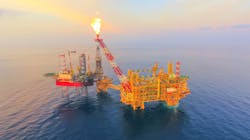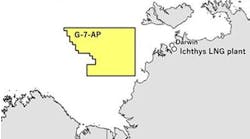Execs share their offshore oil and gas methods for a sustainable future
April 24, 2023
Editor's note: This story first appeared in the March-April 2023 issue of Offshore magazine's Energy Transformation Strategies Special Report.
Compiled by Ariana Hurtado, Editor and Director of Special Reports
“We are focused on building a sustainable enterprise that helps meet the world’s growing energy needs in a safe, environmentally responsible, socially sensitive and profitable way. Offshore, across drilling and completions, subsurface and operations, we are leveraging data analytics, automation, machine learning and artificial intelligence to make faster, better and data-driven decisions, and drive operational improvements. We are also using new technologies to increase productivity and at the same time reduce emissions. In the Gulf of Mexico, Hess used digital twins—a virtual model designed to accurately reflect a physical platform—to enable process equipment condition monitoring and extend reliability on key topsides equipment. From subsea to satellite, we are enhancing environmental surveillance by testing and implementing cutting-edge monitoring solutions including a 3D scan and model of facilities to improve accurate identification of fugitive emissions; working with satellite and aerial providers to monitor for environmental impact; and leveraging data contextualization using emission data to minimize impact on the environment and reduce emissions.”
—Gerbert Schoonman, Senior Vice President, Production, Hess Corp.
“Petrobras is committed to a transition to a low-carbon global economy, and it aims to provide society with affordable energy through safe, efficient, low-cost operations, with lower emissions. To this end, we have implemented pioneering solutions, adopted management indicators and been developing new technology to ensure oil and gas is produced with low emissions. Some of our main solutions include initiatives to reduce gas flaring; carbon capture, utilization and storage; methane detection systems; all-electric systems (electrification for offshore platforms); gas recovery systems; energy efficiency measures and projects to reduce emissions from refineries. Our Strategic Plan (2023-2027) continues to focus on value generation and aims to increase the number of projects on reducing carbon emissions. US$3.7 billion on projects to help with the decarbonization of operations (scopes 1 and 2) are planned, as well as US$600 million toward the BioRefino Program. Petrobras will be installing the first plant in the country dedicated entirely to the production of 100% renewable diesel and aviation biokerosene (BioQAV), as well as other products with a lower carbon footprint, in Cubatão [São Paulo, Brazil]. The company will be using its technical capabilities to make a decisive contribution to reducing greenhouse-gas emissions in the country.”
—Jean Paul Prates, President, Petrobras
“It’s an exciting time to be part of the energy sector. Repsol Sinopec has been on a transformative journey over the past five years. We’re now at a turning point as the industry faces increasing energy challenges. Our aim is to consistently deliver results against our corporate strategy, which is focused on three strategic themes: safe and sustainable operations from our producing assets; efficient decommissioning and emissions reduction; and driving our operations towards net zero. We will focus on maximizing value from our assets whilst prioritizing safe, sustainable oil and gas production. We aim to be the ‘best in class’ for efficient decommissioning in the North Sea and support the energy transition toward net zero. We are also exploring the opportunity to develop a green hydrogen production and export facility in Scotland on the island of Flotta in Orkney. If successful, hydrogen produced from the Flotta Hydrogen Hub has the potential to contribute to both Scotland and the UK’s low-carbon ambitions.”
—Adam Sheikh, Vice President of Decommissioning and Energy Transition, Repsol Sinopec
"Talos provides our customers safe, reliable and responsible energy by supplying oil and gas from offshore basins in the Gulf of Mexico, which ranks as one of the lowest greenhouse-gas [GHG] emissions intensity by global resource type. Our infrastructure acquisition strategy and operated asset base provide the scale necessary to employ measures to reduce emissions cost-effectively and facilitate lower-cost subsea tieback investments with a lower emissions profile than constructing a new platform. This strategy should further reduce our future GHG emissions intensity. We are simultaneously applying our core skill sets to develop large-scale decarbonization projects to permanently store industrial emissions (CO2) along the Gulf Coast region to mitigate the potential effects of climate change. Our Bayou Bend CCS project is the only offshore carbon sequestration lease in the United States, which was awarded by the State of Texas General Land Office."
—Bob Abendschein, Executive Vice President and COO, Talos Energy
“In 2022 Woodside Energy undertook drone surveys on our operated floating production storage and offloading facilities and offshore platforms in Western Australia and the US Gulf of Mexico. The use of innovative drone-based technology is intended to enhance location and quantification of key methane emission sources, enabling the prioritization of mitigation projects in our asset decarbonization plans. Woodside’s methane emissions were less than 0.1% of our production by volume in 2021, already well below the Oil and Gas Climate Initiative (OGCI) 2025 methane intensity target of below 0.2%. In September 2022 we were also the first Australasian company to sign the OGCI’s Aiming for Zero Methane Emissions Initiative, committing to strive to reach near-zero methane emissions from our operated assets by 2030.”
—Tony Cudmore, Executive Vice President Strategy and Climate, Woodside Energy









